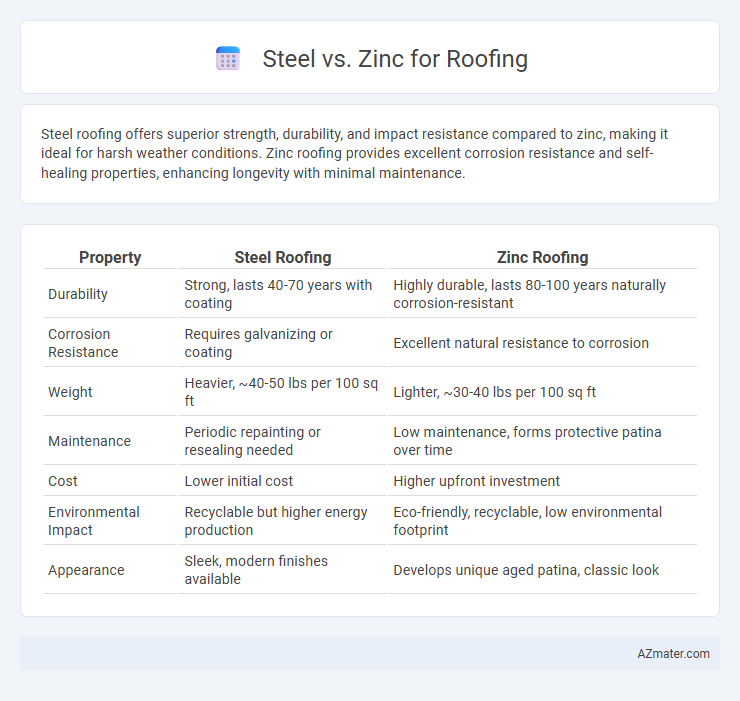Steel roofing offers superior strength, durability, and impact resistance compared to zinc, making it ideal for harsh weather conditions. Zinc roofing provides excellent corrosion resistance and self-healing properties, enhancing longevity with minimal maintenance.
Table of Comparison
| Property | Steel Roofing | Zinc Roofing |
|---|---|---|
| Durability | Strong, lasts 40-70 years with coating | Highly durable, lasts 80-100 years naturally corrosion-resistant |
| Corrosion Resistance | Requires galvanizing or coating | Excellent natural resistance to corrosion |
| Weight | Heavier, ~40-50 lbs per 100 sq ft | Lighter, ~30-40 lbs per 100 sq ft |
| Maintenance | Periodic repainting or resealing needed | Low maintenance, forms protective patina over time |
| Cost | Lower initial cost | Higher upfront investment |
| Environmental Impact | Recyclable but higher energy production | Eco-friendly, recyclable, low environmental footprint |
| Appearance | Sleek, modern finishes available | Develops unique aged patina, classic look |
Introduction to Steel and Zinc Roofing
Steel roofing offers exceptional durability and resistance to extreme weather conditions, making it a popular choice for both residential and commercial buildings. Zinc roofing provides excellent corrosion resistance and self-healing properties, ensuring longevity and minimal maintenance over time. Both materials come in various styles and coatings, allowing customization for aesthetic and functional roofing needs.
Material Properties: Steel vs Zinc
Steel roofing offers high tensile strength and excellent durability, making it resistant to impacts and heavy loads. Zinc roofing provides superior corrosion resistance due to its natural patina, ensuring long-term protection in various weather conditions. While steel is heavier and requires protective coatings to prevent rust, zinc is lighter and self-healing, reducing maintenance needs over time.
Durability and Longevity Comparison
Steel roofing offers exceptional durability due to its high tensile strength and resistance to impact, making it ideal for harsh weather conditions. Zinc roofs provide superior longevity, often lasting over 80 years, thanks to their self-healing patina that protects against corrosion. Both materials resist rust well, but zinc's natural corrosion resistance generally surpasses steel, which may require galvanization or coatings for long-term protection.
Cost Analysis: Steel vs Zinc Roofing
Steel roofing typically costs between $5 to $12 per square foot, offering a more affordable initial investment compared to zinc roofing, which ranges from $10 to $20 per square foot. Zinc roofing provides long-term savings through exceptional durability and a lifespan exceeding 80 years, reducing maintenance and replacement costs. Steel roofing delivers moderate durability with a lifespan of 40 to 70 years, requiring periodic maintenance that can increase the total cost over time.
Aesthetic Appeal and Design Flexibility
Steel roofing offers a sleek, modern aesthetic with a wide variety of finishes, including matte, glossy, and textured options, making it ideal for contemporary architectural designs. Zinc roofing provides a natural, patina-rich appearance that evolves over time, enhancing rustic or historic aesthetics with its unique color shifts from bright silver to soft blue-gray. Both metals allow for versatile panel profiles and custom shapes, but zinc is prized for its superior malleability, enabling intricate designs and complex roof structures.
Environmental Impact and Sustainability
Steel roofs offer high recyclability and a longer lifespan, reducing overall environmental impact compared to many materials. Zinc roofing naturally develops a protective patina that extends durability, minimizing maintenance and waste. Both materials provide sustainable options, but zinc's lower embodied energy and self-healing properties make it especially eco-friendly for green building projects.
Maintenance Requirements and Lifespan
Steel roofing offers high durability with maintenance typically involving rust prevention through coatings and periodic inspections to address scratches or dents. Zinc roofing excels in low maintenance needs due to its self-healing patina that protects against corrosion and extends lifespan significantly. Lifespan for steel roofing averages 40-70 years with proper care, whereas zinc can last over 80-100 years, making zinc a superior option for long-term durability and minimal upkeep.
Weather Resistance and Performance
Steel roofing offers superior weather resistance with high tensile strength and excellent impact resistance, making it ideal for areas prone to hail, heavy rain, and strong winds. Zinc roofing provides exceptional corrosion resistance due to its self-healing patina layer, which protects against rust and extends durability in coastal and humid environments. Both materials perform well in extreme weather; steel excels in structural strength, while zinc offers long-term maintenance advantages with minimal degradation.
Installation Process and Complexity
Steel roofing typically involves a straightforward installation process due to its uniform panels and lightweight nature, allowing quicker handling and fastening. Zinc roofing requires specialized techniques like soldering seams to ensure durability and waterproofing, making it more complex and time-consuming to install. The choice between steel and zinc impacts labor costs and installation time, with steel offering easier installation and zinc requiring skilled craftsmanship.
Choosing the Right Roofing Material for Your Needs
Steel roofing offers exceptional durability and resistance to extreme weather, making it ideal for long-lasting protection, while zinc roofing provides superior corrosion resistance and a natural patina that enhances aesthetic appeal over time. When choosing between steel and zinc, consider factors such as budget, climate, maintenance requirements, and desired lifespan; steel typically costs less upfront and excels in strength, whereas zinc demands a higher initial investment but requires minimal upkeep. Assessing environmental impact and architectural style ensures selecting the roofing material that best aligns with functional needs and sustainability goals.

Infographic: Steel vs Zinc for Roofing
 azmater.com
azmater.com